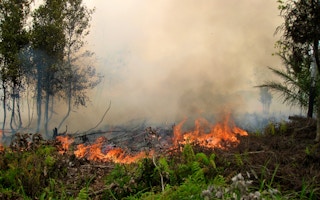When it comes to deforestation – either stopping it or encouraging it – a country’s laws and policies can make a great difference. But no country has just one policy that shapes all outcomes, nor one single authority that controls all sectors. Rather, the laws influencing how land and forests are used (or abused), and the lines of authority that govern them, form a complex, tortuous web where the threads themselves are often unclear, let alone how they all interact.
This certainly describes the legal context in tropical forest countries around the world, where people are trying to make a living from the land, or trying to conserve natural ecosystems, or trying to implement REDD+ or another low-emissions development strategy.
Countries like Peru, Indonesia or Tanzania, for example, have literally hundreds of regulations and norms governing land use, which are issued and enforced (or not) by multiple offices within government – including forestry, environment, agriculture, finance or mining departments, for example – and by multiple levels, from national presidents to village chiefs.
Some of the most critical powers and responsibilities that different government offices have, and that affect how land is used, include classifying lands, titling lands, authorizing concessions and use permits, creating protected areas, offering incentives for conservation (like payments for environmental services), and delivering incentives for agriculture and ranching like subsidies, credit, and technical assistance.
How land is classified can determine what uses are permitted on it, and even who can hold what types of rights to it. Land classification is often presented as a technical process, but in fact it’s rather political: which ministry or office controls land classification, how participatory it is, and to what degree it is binding can have a profound influence on land use.
Titling and issuing permits over land can determine not only how land is used, but also who can make decisions about land-use initiatives or benefit from them. And subsidies, credit, and access to markets are always operating in the background, incentivizing one type of land use or another, be it conservation for biodiversity or conversion for exportable cash crops.
Prying into this web of laws and policies – trying to disentangle the threads and knots to understand how they tie together – gives remarkable insight into the legal forces that help or hinder efforts to achieve low-emissions development.
Five countries, hundreds of law
We reviewed hundreds of norms and regulations for five countries – Peru, Indonesia, Tanzania, Mexico and Vietnam – and uncovered an array of legal forces at work. The legal environments in these countries are highly diverse, but some common elements emerged. These were largely related to decentralization, clarity (or rather confusion) around which government agency is responsible for what, and to the development priorities that the law supports.
We also saw that, usually, different ministries carry out government policies in each distinct sector, but that the level of authority and responsibility that they give to their administrative subdivisions at regional and local level varies greatly across countries.
In Indonesia, the autonomy of the districts has waxed and waned in a sort of tug-of-war with the central government since post-Suharto decentralization. Recently, land-use governance has been “defined” by a very large number of agencies with often overlapping authorities.
For example, district governments have had considerable authority to dole out concessions for crops such as oil palm, but forestry itself is controlled largely by the central government. Meanwhile, the many dimensions of REDD+ are influenced by at least four central government offices with provincial involvement as well. This raises questions as to who will really “run” REDD+, and reveals how many agencies may need to be involved in a national REDD+ program.
In Peru, where decentralization is more recent, key powers related to binding land classification and titling are housed in the agricultural offices at both national and regional levels, while mining concessions are authorized by the mining sector offices.
Meanwhile, the Ministry of Environment controls a “territorial planning” process that isn’t binding, and also protected areas, although some of those powers have been recently moved one level up to the entire cabinet. In this way, the environment sector’s powers are relatively limited in practice, even as the Ministry continues to bear the main responsibility for developing and deploying REDD+ policy in Peru.
“
Prying into this web of laws and policies – trying to disentangle the threads and knots to understand how they tie together – gives remarkable insight into the legal forces that help or hinder efforts to achieve low-emissions development.
Tanzania faces its own complications related to decentralization. While the Tanzanian Forest Service has derived revenues from forestry since its creation in 2015, districts, villages, and NGOs have moved land out of the former’s purview by creating village land reserves, including as part of REDD+ projects. Meanwhile, key environmental authority, including those related to a future national REDD+ program, have been moved to the Vice President’s office.
Thus, the NGOs, donors, villages and districts that to date have moved REDD+ projects forward are clearly distinct from the institution that is legally required to drive the future national program, and moreover exist in tension with the national forest service. This raises another question: how might REDD+ end up altering such politics?
While Vietnam’s unitary communist state is ostensibly highly centralized, land use change initiatives – ranging from acacia plantations to payments for environmental services – must actually be approved by multiple levels of government. Despite these many layers of approvals, our related research has shown that local people don’t always understand initiatives fully.
Mexico’s federal government with its relatively padded domestic budget stands out in some respects. The National Forestry Commission, housed in the environmental secretariat, has taken a leading role in REDD+ policy and in deploying payments for environmental services.
In addition, Mexico is unique in having much of its land held collectively by local communities as “social property,” or ejidos. While ejidoshave legal autonomy, government offices are also legally empowered to work with them by extending agricultural credit or enrolling them in PES schemes. Which government agency an ejido encounters may therefore affect what type of management strategy it adopts.
In all countries, one entity may at times make decisions that are the legal purview of another, leading to conflict and halting implementation, but also moving some agencies into participating in the policy arena on low carbon land uses in potentially unexpected ways. For example, in Indonesia, the Ministry of Finance followed up on efforts by the then Ministry of Forestry to address benefit sharing from forest-carbon activities after Finance had deemed efforts by Forestry to be invalid.
Systemic challenges
Despite this diversity of legal arrangements across study countries, we observed several common challenges. In particular, environmental offices tasked with conservation often lack the legal powers that would enable them to transform the traditional trajectories of land-use change. By contrast, agricultural and mining offices, whose agendas often include forest conversion for production and resource extraction rather than conservation, are generally more empowered to advance their goals.
This is not to say that the particularities of policy don’t matter – they certainly do. Whereas sub-national governments in Peru and Indonesia have sold, titled, or permitted land to facilitate conversion to oil palm, “social property” has made this much more difficult in Mexico.
That doesn’t mean that policies in Mexico never support deforestation: Subsidies and credit policies can and indeed have. At the same time, however, the Mexican environment secretariat has considerable authority to deploy payments for environmental services and manage protected areas – positive signs for low-emissions development.
The main point to note is that a country’s legal arrangements set the parameters within which different visions of development and their attendant political priorities are negotiated. Understanding them is a critical step in identifying which government offices are relatively empowered, and why. With better information on these legal realities, policy makers, NGOs, local communities, and activists can better diagnose systemic challenges and develop innovative and sensible solutions.
Anne Larson is a principal scientist for CIFOR. Ashwin Ravikumar is a scientist at CIFOR. This post is republished from the CIFOR blog.











